

For its 125th anniversary in 2012, Columbia Records hired Sean Wilentz to write a corporate history. It was a new kind of project for Wilentz, a history professor accustomed to following his own muse in a career that has included books on 19th-century American democracy as well as a biography of Bob Dylan. Wilentz insisted upon complete creative control. Columbia granted it.
Sumptuously illustrated, 360 Sound: The Columbia Records Story, published by Chronicle Books in November, traces the venerable firm from blackface minstrelsy through jazz, big bands, rock ’n’ roll, and hip-hop. The title comes from a 1960s slogan celebrating breakthroughs in high-fidelity recording.
What Wilentz thought would be a brief endeavor turned into a two-year trek. “There’s not much of a scholarly literature on the history of the recording industry,” he explains. “That’s liberating in that you aren’t following somebody else’s lead,” but makes research more difficult.
He had to get up to speed quickly on the history of sound technology, in which Columbia prided itself as an innovator. No achievement was more important than the company’s introduction, in 1948, of the 12-inch, long-playing phonograph record, which the world came to call an “album.”
“I was writing about things I knew relatively little about, including graphic design,” Wilentz says. Columbia hired a designer to develop packaging for its albums: folded cardboard with catchy artwork. Thus was born the album cover, an artistic milestone.
Dylan played a crucial role at Columbia, which hired him as an unknown in 1961. “Before that time, Columbia was best known for its albums of American standards [meant for sing-along] and was particularly wary of rock ’n’ roll,” Wilentz says. “Then they picked up this scruffy folksinger down in the Village.” Dylan set a pattern for the company as he shifted from acoustic folk to the amplified beat, and it became the biggest rock label in the world.
Wilentz avoided interviewing people — “I didn’t want a collage of interviews” — making exceptions only for the managers of Dylan, Barbra Streisand, and Bruce Springsteen. Nor does he whitewash Columbia’s missteps. “Sometimes corporate histories are celebrations,” says Wilentz, “but this one is full of skulduggery and machinations. There were rivalries and hurt feelings, most of which I put in.”
“I tried to write the history of a business and place it within its larger cultural, artistic, social, and economic context,” he says. Even as the book highlights Columbia’s long run, it reminds us of lost greatness: Record companies’ finances have been hammered in the Internet age. Notwithstanding its current superstar, Adele, Columbia’s future remains uncertain, Wilentz concedes: “I wasn’t sure if I was writing a book or an obituary.”
